I hate spoilers, but here’s something you should know about Detroit: Become Human. The character you are playing may die depending on the choices you make in the game.
And the death of one character does not mean the game is over – you just miss that part of the narrative and carry on the story with other characters.
Now if that upsets you, you can either look for spoilers online elsewhere to avoid anyone dying or just play another game.
Detroit: Become Human is not your typical video game. Instead, it is an interactive drama with rather simplistic gameplay but with a complex cause-and-effect story tree spanning three different lead characters.
Whatever actions and decisions you take will have consequences on the character you are playing as well as others in the game. There are occasions where their paths will cross, so you have to decide how you want the overall story to pan out.
Think of it as a “Choose your own adventure” book but with three characters and stories that are intricately intertwined.
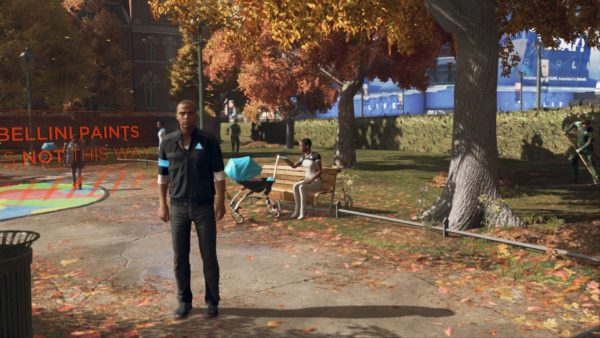
Story
Detroit: Become Human is set in the near future of 2038, where androids who look and act exactly like human beings are readily available as domestic appliances and walk among humans on the streets.
The city of Detroit looks shiny and modern, while some parts look abandoned and decrepit. There were clear signs of discrimination – Androids are relegated to stand at the back of the bus, and are faulted for making humans lose their livelihoods.
You play three different CyberLife android characters. The first is Connor, an RK800 investigative android who assists the Detroit police in solving cases related to deviant androids. He is partnered with a grumpy and troubled cop Hank, who dislikes androids for personal reasons.
Then there is Markus, an RK200 butler and caregiver android for Carl Manfred, an old and wheelchair bound artist played by Lance Henriksen, who played the original android, Bishop, in Aliens.
Finally, there is Kara, an AX400 nanny and domestic helper android whose love for her charge, a little girl named Alice, made her go beyond her call of duty.
You play each character’s story a chapter at a time, first Connor, then Marcus, then Kara and then back to Connor again, although later in the game, you might have to play all three perspectives in the same chapter as their paths converge.
Without giving away too many spoilers, all I can say that Detroit: Become Human is a gripping and immersive sci-fi drama with characters you feel personally responsible for, although it can be rather heavy on violence.
With a combination of an engaging theme, strong characters and immersive cinematic treatment, and an impressive number of permutations in the story, Detroit: Become Human is an experience that is worth reliving.
There are so many ways that the story can go, and your decisions early in the game can impact your options much further on. The game weaves this in beautifully and reminds you how your choices now can have far greater consequences than you can imagine.
Detroit: Become Human tackles the theme of human ethics for dealing with androids who become sentient.
For fans of movies such as A.I. Artificial Intelligence, Ex Machina, Blade Runner, Terminator, as well as Philip K Dick’s and Isaac Asimov’s sci-fi novels, you will love how this game deals with the theme and gets you involved in how the story develops.
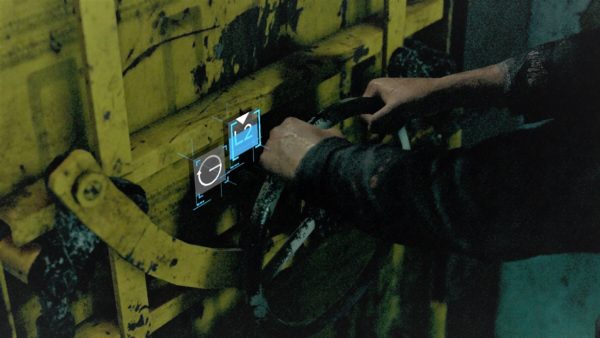
Gameplay
Gameplay is technically simplistic, involving some button mashing and timed presses of the buttons shown onscreen, as well as simple combos of buttons and thumbsticks.
Certain actions are rather unnecessary and meaningless, and felt more like they were put there so you had something to do or interact with.
For instance, you had to press a button and twiddle the thumbstick to open doors in a ship, or clean up various rooms around the house.
In other chapters, your failure to hit the buttons at the right time can decide the fate of characters, and whether they live or die – the story can still continue nonetheless, although it might not be the way that you want.
Overall, the pacing of the game is not very consistent – some parts are quite draggy while others are intense and make your palms sweaty.
Some decisions force your hand by running a timer down so you cannot take too long to take action. I made that mistake once and my indecision caused a minor character to be killed.
Although I was tempted to replay that chapter just to see what I missed, the game advised me not to do that as the story would change based on my latest playthrough. I continued regardless, but I kept wondering what if I acted and how things would have been different.
In the same playthrough much later in the game, my poorly timed button pressing caused my character to be wounded, and a minor character had to sacrifice itself to save my character’s life.
This was something I could not live with so I had to go back and replay that chapter again after I completed the game. Of course, this meant that the events going forward will also be altered, so I had to play through the rest of the game again.
So if you are a completist or perfectionist who refuses to read spoilers, or if you want to see the alternate endings for certain characters, be prepared to play through the game a few times going through the different options.
The game incorporates the use of the controller cleverly, using the speakers for the game’s interface sounds, and also changing colours when you play the different characters – blue for Connor, yellow for Markus and green for Kara.
It will also flash red if your character is critically unstable. In addition, the touchpad on the controller is also utilised for flipping through magazines scattered around the game or mundane tasks like mopping (yes, you actually have to play a character doing housework).
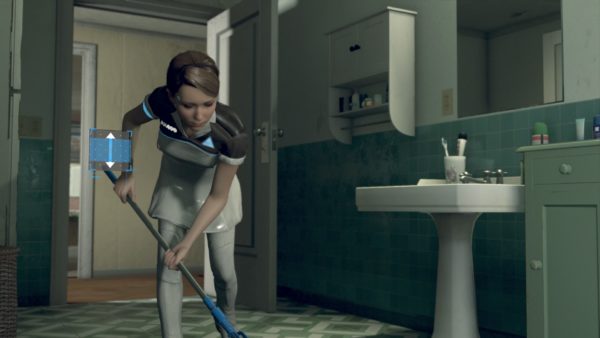
What I enjoyed are the Connor missions, where you have to investigate clues at crime scenes and reconstruct events that happen.
Again, it is rather simplistic since objectives are highlighted in yellow when you press the R2 button – what makes it challenging actually finding all the clues when you are hindered by the poor camera angles.
Despite its simplistic gameplay, Detroit: Become Human taps on your emotions, moral compass or experimental spirit to guide the responses and behaviour of your android.
Your actions will affect the behaviour of the characters you interact with, the dialogue options that you have, as well as how the chapter and the overall story will pan out.
A flowchart is shown at the end of each chapter so you can study at which point in the game your choices might have changed your ending.
You can also view global stats to see how other gamers had reacted to the situation as compared to what you did, which I thought was quite innovative and interesting.
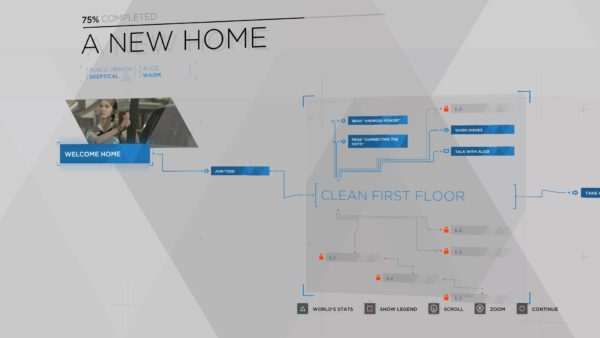
Sight and Sound
Detroit: Become Human is beautifully produced with blockbuster quality cinematography and lifelike action rendered by motion capture of human actors.
It boasts of a professionally scored soundtrack composed by three composers, one for each of the three protagonists. I felt Kara’s haunting cello theme was the most enjoyable one.
Overall, the graphics and sound work well as an interactive drama especially for the cinematic cutscenes, but the camera angles do not translate well in actual gameplay in a third person perspective of the character you are controlling.
At times, the camera follows too close to the character and you cannot see where you are going. Other times, camera directions will switch while you are moving, which is very disorienting when you are trying to control your character.
Furthermore, you cannot turn to look behind you – instead you press the R1 button to flip the camera around 180 degrees, but when you switch back, it is in a different position from where you were looking at previously.
In order to survey a crime scene thoroughly, you need a combination of thumbsticks, R1 buttons and walking and turning around a few times just to see the entire room.
Also, the view keeps forcing you to turn back to the centre of the screen, which can bring on a bout of seasickness if you insist on looking around constantly while walking.
The game also restricts you on where you can walk to, which is a shame since the world of Detroit looks like an interesting place to explore. Sadly, this is not an open-world game.
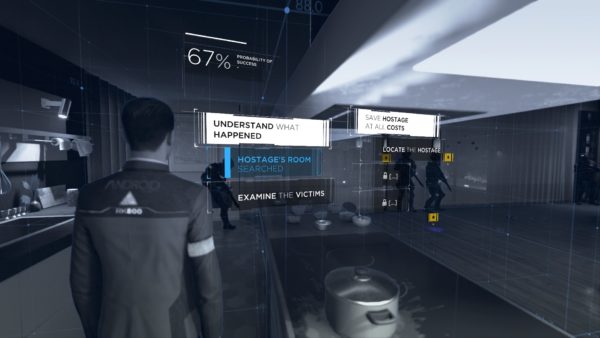
Detroit: Become Human is not recommended for very young players due to plentiful swearing and violence, as well as complex and mature themes.
Some of the scenes are rather disturbing, depicting the androids and vulnerable humans who suffer at the hands of violent humans.
Although rather heavy handed in showing how terrible humans are, it is a great story for a more matured audience who enjoy the theme of artificial intelligence becoming sentient.
By playing through the game, you can get points to unlock bonus materials, such as behind the scene and “making of” videos, as well as image galleries and artwork, which are interesting to see.
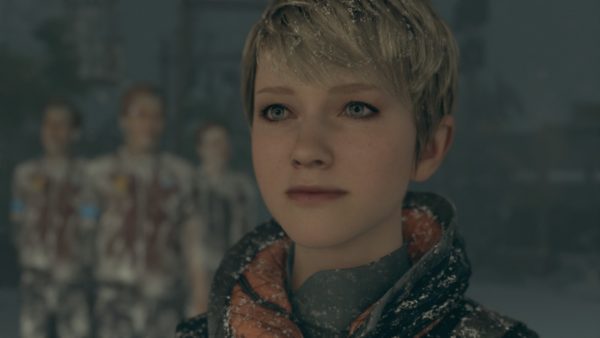
TL;DR
Detroit: Become Human is a must for fans of the sentient android theme and those who love a story-driven game over gameplay.
The complex story tree involving three different characters and the “cause and effect” narrative will encourage some replayability to see how different options can lead to different endings.
However, the “press a button for the sake of interacting with something” even for mundane actions and simplistic, inconsistent gameplay may not sustain gamers’ interests for long.
Detroit: Become Human for the PlayStation 4 retails at S$64.90 for the Standard Edition, and the Deluxe Edition with the soundtrack and digital artbook will set you back by S$78.90.






